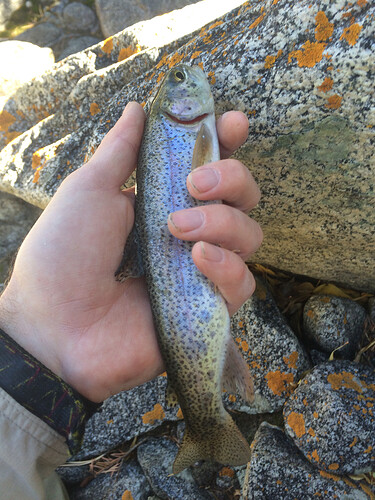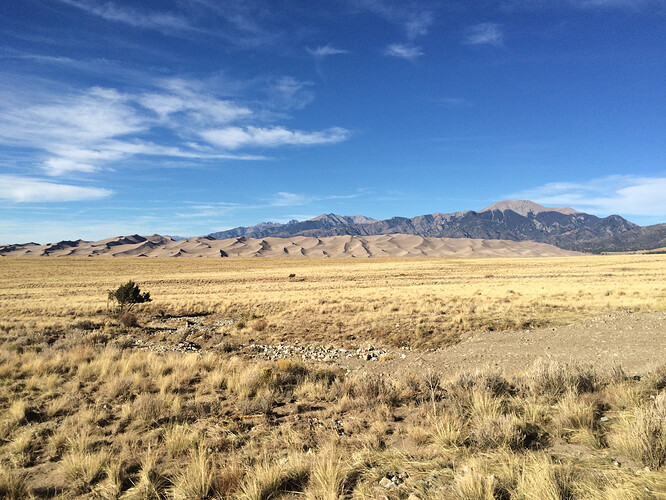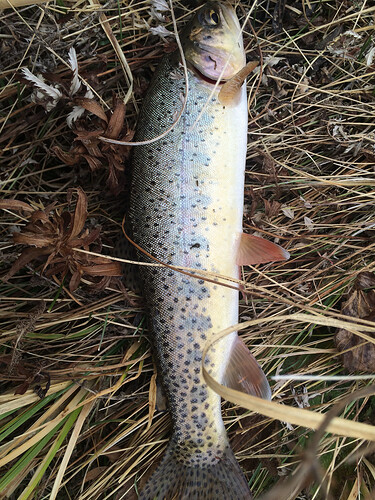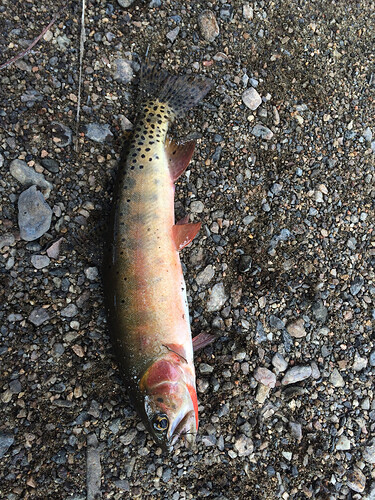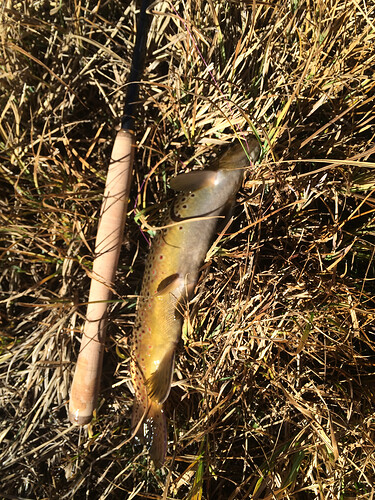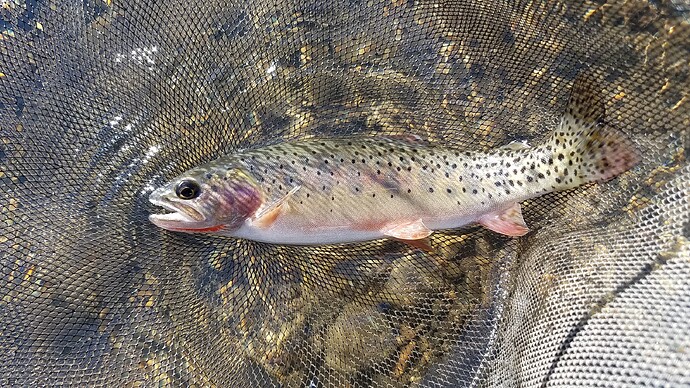So I’m sadly back in China after 21 days in Colorado & New Mexico.
Fished a wide variety of streams and rivers. By the time I landed in Denver on October 9th, snow had started falling at higher elevations in RMNP and the colder weather at higher elevation was to be a strong limiting factor on my fishing plans for the park and Indian Peak wilderness. My first 8 days in Colorado I alternated between fishing up high on the branches of the St. Vrain and Boulder Creeks and lower down in the canyons. Since I was wet wading, lower down was less cold and the warmer condition meant more active fish to catch. My memories of the great fishing at higher elevation during the TUSA summit last year were to be just that. Higher up was just plain too cold for wet wading and the near freezing water temps resulted in slow days with frequent stops to let my feet regain feeling. The scenery up high was just gorgeous however and the few Cutthroats I managed to catch made up for the pain.
After the first 4 days of this I headed into RMNP with a friend for a backcountry traverse along the divide into some lakes and streams know for having decent fishing. The off trail backpacking turned out to be great with the fresh snow providing lots of wildlife trails to identify and gorgeous light. Unfortunately, the fish were mostly absent and with incredibly windy conditions making it impossible to fish. We had a mini epic getting back to our car across the divide on our last day. Note to self: Heed the cold and wind warnings in RMNP. Second note to self, no more backpacking in October in places that have campfire bans. Long nights of cold darkness without a campfire is masochism.
Boulder Creek and the St. Vrain in Lyons Canyon consistently provided solid Tenkara fishing for mostly Browns and some Rainbows. The fishing was never too technical nor easy and kept things interesting. Local fishermen have it good here and I was surprised how few anglers, Tenkara or otherwise I saw on the water, despite an abundance of fly shops. I would have a hard time staying in the office midweek if I lived here.
After a few days without fishing when attending a work conference in Colorado Spring I headed down to New Mexico and Southern Colorado.
I spent a week fishing this part of the Rockies starting at the foot of the Spanish Peaks in Cuchara CO, where I fished Cucharas Cr. and the North Fork Purgatoire river. Both fairly slow destinations with Cuchara Cr. being mostly a waste of time. An early morning ascent of West Spanish Peak (13,628’) made for a nice non-fishing diversion.
I then traveled further south, crossing into New Mexico and heading west into to the Cimarron River Canyon which yielded good fishing for Browns but exacted a steep price. A newish Iphone 6S fell out of my shirt pocket and got washed aways during high flows as a result of a busted beaver dam. I moved further west to Red River. I fished both the upper section just below the ski resort and the lower section near the hatchery where I caught the largest Rainbow trout of my life. This fish really putt my new Daiwa rod to the test, exciting times. I’ll always remember pawing that fish to shore like a hungry grizzly bear after my tippet broke when trying to land that pig. But with no phone, the fish will have to remain a memory. Needles to say it was a bittersweet moment.
After a relaxing night in Taos, soaking in the local culture and trying to get over my lost tech, my second day in New Mexico found me in the Sangre de Cristo Mountains , just inside the Carson National Forest boundary at 9,000’ on the banks of Costilla Creek landing Rio Grande Cuts and Cutbows, lazily moving upstream from pool to pool. One of the best day I’ve ever had. Completely alone, midweek, on a gorgeous fall day catching Native fish in a gorgeous meadow with no trees or bushes to lose flies to, willing fish, behaving as expected. Elk tracks littered the sand bars of the stream, with hunting season getting under way everywhere I wore my bright Orange Houdini religiously and empathized with the animals that had been wandering the creek bed earlier that day. No one will ever call fishing for Cutthroats difficult, but sometimes that’s just what one needs. What a treat and what a way to get over the previous day’s loss. By the end of the day, satisfied with my biggest catch yet I made my way back to Colorado driving north into the San Luis Valley to get ready to fish Rio De Los Pinos per Adam’s recommendation.
When I arrived at the Trujillo Reservoir Parking lot the next morning at 10,000’ I found ice, lots of ice choking the inlet to the reservoir and despite the sunshine and warming air my hopes of still finding fish in the meandering Trujillo meadow stream were pretty low. I stayed nonetheless and proceeded to find as promised by Adam a nice cache of large Brown Trout still holed up in the scattered pockets of deeper water throughout the bends of de Los Pinos. This late in the season and with really low water they were unfortunately (for me at least) getting pretty spooky and the fishing was not easy. The contrast from the previous day was obvious and I savored the moment. For a bit I had the meadows to myself but was not catching anything and then another angler showed up and I gathered that perhaps the fishing was still on. I spent several hours observing wary fish ignore my flies or scatter at my approach. After lengthening my line by an extra meter or so and tying on a bushier ant/gnat pattern I finally managed to land what is definitely the longest Brown Trout I’ve ever caught. It was a gorgeous fish that unfortunately proved to be the only catch of the day. Still a great way to spend a day in a gorgeous place with many lessons learned while observing the fish holding in shallow water, pockets, riffles, undercut banks, scattering at unbelievable speeds up and downstream when spooked by shadows or clumsy casts, my respect for these creatures only increased as the day went on. Endless lessons in aquatic biology as I watched the struggle for life as winter takes over the stream ecosystem. The fish and the river will always teach a willing student.
I had planned to head further north into the South San Juan Wilderness to hunt down more Rio Grande Cutts on Lake Fork but my rental compact didn’t inspire enough confidence for me to move further up the Conejos valley to fish it and its tributaries. After 20 miles of worsening FS road quality I reluctantly turned around and headed back to the blacktop to make my way further north for one last day of fishing in the upper Arkansas watershed. A side trip to Great Sand Dunes was a worthy deviation as were some nearby hot springs.
Chalk Creek is a small stream I had read a bit about in my research for a final piece of water to fish on my way to Leadville. I pulled up along side this tributary of the Arkansas inside the San Isabel NF boundary on a brilliant sunny fall day and although off to a slow start the fishing quickly warmed up, never getting too easy and producing just enough feisty browns and rainbows of decent size and spirit. The pools, pocket water and gradient proved to be perfect Tenkara water and I could of easily spent another day or two continuing upstream to explore its headwaters. By the end of the afternoon I had decided this would be the day I would keep my first meal as a way to celebrate the end of this road trip. A nice size rainbow was soon in my hands. I had not killed a fish since my trip to Sierras in 2014. It’s never something I find easy to do, but eating fresh trout is one of life’s greatest pleasure. A sharp knife made everything easier.
Back in Leadville I grilled the fish and savored the cooked flesh, washing every bite down with warm sake under the stars. I grilled the bones and soaked them in the last of my sake savoring the fish infused cup. It had truly been an incredible trip. Fishing a dozen different rivers all over the southern rockies, catching 2 native species of cutthroats and 3 non-natives, all wild fish and continuing to learn more about what makes Tenkara so special all along the way. Sure September would of been a better time of the year to be here, but I couldn’t control the timing and having been here during the last days of the season, with hardly anyone to share the rivers with, under gorgeous light, made it more than challenging but inspiring which is sometimes just what one needs to sharpen ones skills.
Notes on gear:
Rods. I flew to the US with only one rod, knowing I would be picking up several I had purchased over the last six months.
I fished a Tenkara Centre UK 12’4" Otaki that had been given to me in China by Bryan Smith to try out for several days. After picking up all my accumulated mail since leaving the US back in February I had a broader quiver with a new Nissin Oni 395 rod; A Daiwa Enshou LL36; and a short Nissin Air Stage 240.
The Daiwa proved to be my most used rod in subsequent days, primarily due to its lengths, but also thanks to its superb handling and durability. I’m not always kind to my rods and this rod handled all of my abuse and kept catching and landing fish. It’s a bit beat up from several falls but it fishes on with surprisingly no tip breakage. I might go into more depth as to how it compares to the Tenkara Centre rod in a later post.
The nicest surprise was the Nissin Oni rod which is a real pleasure to cast and fish. So much power in that rod. At nearly 4 meters it stayed collapsed more often than not due to the overhead trees, but I savor the days when the canopy allowed me to cast it, the muscle memory just puts a smile on my face.
The biggest disappointment was the 240cm Nissin Air Stage which proved to be just too short and too soft for my taste. After just a few casts I promptly repackaged and returned it. After much fishing this fall maybe my skills and and experience had evolved to the point where that rod just didn’t feel right. I still definitely see the need and use for a short rod on brush choked streams, this is just not the rod for me. The ideal rod might be a 270cm and cast like the Suntech Kurenai.
As a backup I’ve started carrying a 300cm Nissin mini in my pack, but other than a few casts on the upper Meekong in China earlier in October I have happily yet to really test this rod.
I mostly fished a mixture of self tied kebaris, as well as bead/beadles nymphs. Like last fall in Shenandoah prince nymphs and copper johns were always productive. Kebaris tied with a peacock ice dub collars were my favorite and seemed to be popular with the fish too. I had run out of my usual favorite,the wool bodied killer kebaris early in the trip and my biggest regret was not having a vice and tying tools with me to replenish my fly box. I did pick up some nice wool in a Colorado Springs knitting shop along with enough hooks to start replenishing. After over 20 days of solid fishing these last two months I had lost enough flies that I was forced to fish with what was left in my box which was good to push me out of my comfort zone. Some days the fish were picky enough that fly choice seemed to matter, most days it didn’t and casting accuracy and fly impact on the water surface was usually the determining factor.
During September when I fished in Japan, coaching by amongst other Go Ishii and Oni had me start fishing using both a longer ( 4m minimum) and a thinner 2 or 2.5 weigh level line and I continued with this approach on this US trip. Previously I’d fished a 3 or 3.5 weight. I also started tying a short length of different colored line on the end as a sighter. The thinner line is definitely more of a challenge to see and having a color change on the hook end is helpful. As my skills have improved I don’t see going back to a heavier line, unless wind dictates. Being able to solidly cast a longer line using a 4m rod has allowed me to consistently probe more lies, further out which has been a real benefit. Last season I learned where to find fish, this season has been all about learning how to coax fish out of those spots. What a trip!
src=“/uploads/default/original/1X/23e9928158d637b03d0dd64774ae37e13d1c7ac5.jpg” width=“375” height=“500”>
